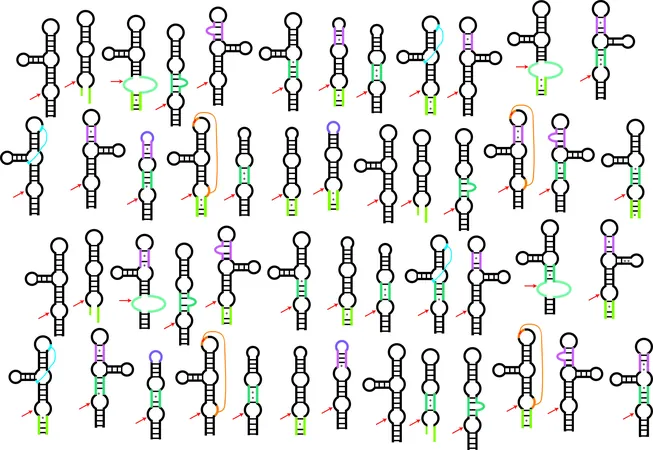
Breakthrough in RNA Research: First 'Twister Ribozyme' Discovered in Mammals!
2024-11-05
Author: Li
Introduction
Scientists at Penn State University have made a stunning breakthrough in the field of molecular biology, unveiling the first-ever 'twister ribozyme' found in mammals—specifically, in the genome of the bottlenose dolphin! This incredible discovery could reshape our understanding of how life once began on Earth and enhance our knowledge of RNA's functional capabilities.
The RNA World Hypothesis
The exciting findings stem from the long-debated "RNA world" hypothesis, which suggests that early life forms were primarily based on RNA, a single-stranded molecule like DNA but with the ability to also function as an enzyme. The researchers tested the activity of over 2,600 predicted RNA sequences that belong to a unique class of RNA enzymes called 'twister ribozymes.' Remarkably, approximately 94% of these ribozymes demonstrated self-cleaving activity, meaning they can cut themselves into pieces, highlighting their robustness even amid structural imperfections.
Innovative Techniques
The research team developed a groundbreaking technique referred to as the "Cleavage High-Throughput Assay" (CHiTA), which enables them to evaluate thousands of these ribozymes efficiently in a single experiment. Before this study, only a handful of twister ribozymes had been validated, despite thousands being hypothesized based on genomic sequences. The ability to analyze so many at once opens the door to potential discoveries awaiting in nature—the researchers identified an additional 1,000 ribozyme candidates through meticulous genomic analyses.
Significance of the Discovery
So, what makes this discovery so significant? Unlike conventional DNA, which has a rigid double-helix structure, RNA can fold into diverse shapes—loops, bulges, and helical structures. This variability is what enables RNA enzymes to perform various biochemical functions. By focusing on twister ribozymes, the researchers not only found a previously unidentified type of ribozyme but also showed that their function is forgiving to minor structural variations, which means that there might be even more undiscovered ribozymes lurking in the genetic codes of various organisms.
Implications for Understanding Early Life
Given the vast implications of this research, it raises profound questions about the adaptability of early life forms. "This research expands our understanding of the tolerance of RNA structures," said Professor Phil Bevilacqua, the lead researcher. "By understanding these variations, we can better identify and investigate these molecules, shedding light on possible RNA functions in primitive life forms, which could be a key element in understanding how life began on Earth."
Conclusion
With the completion of this study, the future seems bright for RNA research, paving the way for further exploration into the role ribozymes play in cellular function and evolution. The implications of harnessing these molecules could transcend biology, influencing fields such as synthetic biology and biotechnology. As we stand on the brink of new discoveries about life's origins, this remarkable study not only spotlights the resilience of RNA but also sets the stage for a revolution in how we view biochemistry in the context of evolutionary history. Stay tuned as we follow the implications of this groundbreaking research!


 Brasil (PT)
Brasil (PT)
 Canada (EN)
Canada (EN)
 Chile (ES)
Chile (ES)
 Česko (CS)
Česko (CS)
 대한민국 (KO)
대한민국 (KO)
 España (ES)
España (ES)
 France (FR)
France (FR)
 Hong Kong (EN)
Hong Kong (EN)
 Italia (IT)
Italia (IT)
 日本 (JA)
日本 (JA)
 Magyarország (HU)
Magyarország (HU)
 Norge (NO)
Norge (NO)
 Polska (PL)
Polska (PL)
 Schweiz (DE)
Schweiz (DE)
 Singapore (EN)
Singapore (EN)
 Sverige (SV)
Sverige (SV)
 Suomi (FI)
Suomi (FI)
 Türkiye (TR)
Türkiye (TR)
 الإمارات العربية المتحدة (AR)
الإمارات العربية المتحدة (AR)